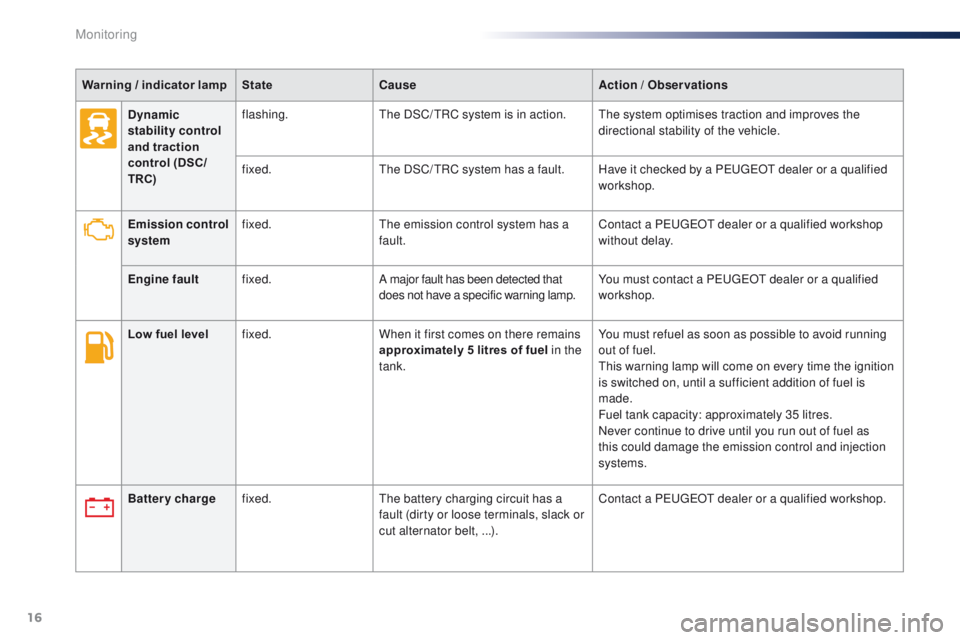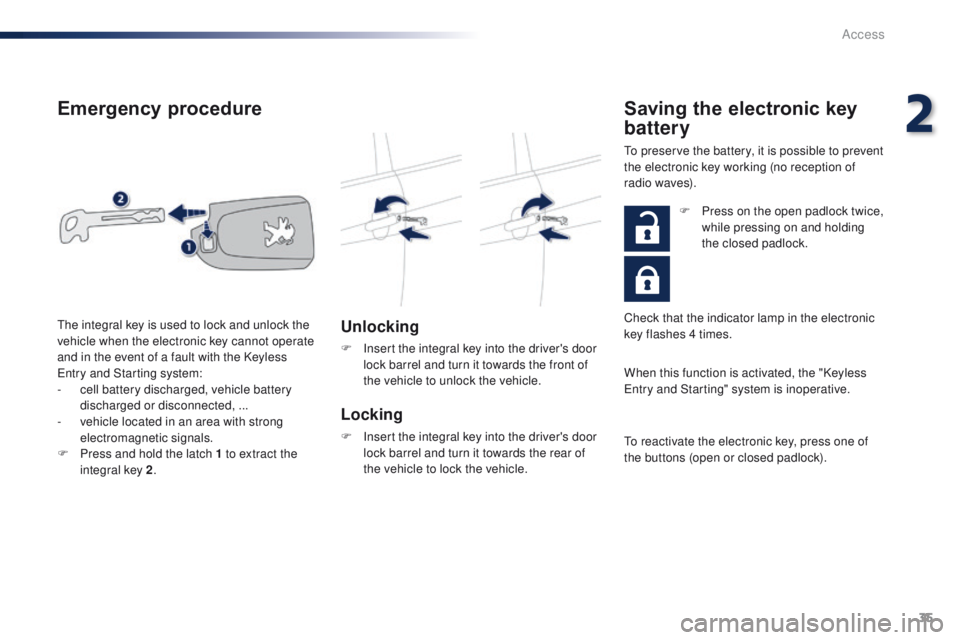2015 PEUGEOT 108 battery
[x] Cancel search: batteryPage 5 of 271

.
.
108_en_Chap00a_sommaire_ed01-2015
Direction indicators 101
Horn
10
1
Hazard warning lamps
1
02
Under-inflation detection
1
02
e
SC system
1
05
Active City Brake
1
08
Seat belts
1
13
Airbags
116
Safety
Child seats 1 21
Deactivating the passenger's front airbag
1
24
ISOFIX child seats
1
30
Child lock
1
35
Child safety Checks
Fuel tank 1
36
te
mporary puncture repair kit
1
38
Changing a wheel
1
43
Snow chains
1
48
Changing a bulb
1
49
Changing a fuse
1
54
12 V battery
1
63
el
ectrical energy economy mode
1
66
Changing a wiper blade
1
66
to
wing the vehicle
1
67
Fitting roof bars
1
68
Accessories
169
Practical informationte chnical data
7-inch touch screen 183
Radio 223
Audio equipment and telematics
Visual search
Alphabetical index
B o n n et 17 2
Petrol engines
1
73
Checking levels
1
74
C h e c ks
17 7
en
gines
1
79
Weights
180
Dimensions
1
81
Identification markings
1
82
Contents
Page 18 of 271

16
Low fuel levelfixed. When it first comes on there remains
approximately 5 litres of fuel in the
tank. You must refuel as soon as possible to avoid running
out of fuel.
th
is warning lamp will come on every time the ignition
is switched on, until a sufficient addition of fuel is
made.
Fuel tank capacity: approximately 35 litres.
Never continue to drive until you run out of fuel as
this could damage the emission control and injection
systems.
Battery charge fixed.
th
e battery charging circuit has a
fault (dirty or loose terminals, slack or
cut alternator belt, ...). Contact a P
e
uge
Ot
dealer or a qualified workshop.
Emission control
system
fixed.
th
e emission control system has a
fault. Contact a P
e
uge
Ot
dealer or a qualified workshop
without delay.
Engine fault fixed. A major fault has been detected that
does not have a specific warning lamp. You must contact a P
e
uge
Ot
dealer or a qualified
workshop.
Dynamic
stability control
and traction
control (DSC/
TRC)
flashing.
th
e DSC/
tR
C system is in action.
th
e system optimises traction and improves the
directional stability of the vehicle.
fixed.
th
e DSC/
tR
C system has a fault. Have it checked by a P
e
uge
Ot
dealer or a qualified
workshop.
Warning / indicator lamp
StateCause Action / Observations
Monitoring
Page 21 of 271

19
108_en_Chap01_controle-de-marche_ed01-2015
Warning / indicator lampStateCause Action / Observations
Keyless Entr y
and Starting
system flashing quickly.
th
e steering column has not been
unlocked. Change to "
OFF" mode, then " ON" mode and turn the
wheel slightly to unlock the steering column.
flashing, accompanied
by an audible signal.
th
e battery in the electronic key is
discharged. Replace the battery.
Refer to the corresponding section.
You are leaving the vehicle without
activating " OFF" mode. With the electronic key on your person, press the
S
tA
R
t/
S
tO
P button to change to "OFF" mode.
th
e electronic key has not been
detected. Check that you have the electronic key with you.
th
e Keyless e
n
try and Starting
system has a fault. Have the system checked by a P
e
uge
Ot
dealer or a
qualified workshop.
Lane depar ture
warning system flashing (orange),
accompanied by an
audible signal. A lane marking is being crossed, on
the right.
tu
rn the wheel in the other direction to return to the
correct trajectory.
For more information, refer to the corresponding
section.
A lane marking is being crossed, on
the left.
fixed.
th
e lane departure warning system
has a fault. Have the system checked by a P
e
uge
Ot
dealer or a
qualified workshop.
Active City
Brake flashing, accompanied
by an audible signal.
th
e Active City Brake system is in
action.
th
e system optimises braking to avoid a collision.
For more information, refer to the corresponding
section.
flashing.
th
e Active City Brake system has a
fault. Have the system checked by a P
e
uge
Ot
dealer or a
qualified workshop.
1
Monitoring
Page 34 of 271

32
108_en_Chap02_ouvertures_ed01-2015
Battery ref.: CR 2016 / 3 volts.
F un clip the cover using a small screwdriver
in the cut-out.
F
L
ift of the cover.
F
R
emove the old battery from its housing.
F
F
it the new battery in its place, observing
the direction of fitment.
F
C
lip the cover in place.
Changing the remote
control battery
Do not discard the remote control
batteries, they contain metals which are
harmful to the environment.
ta
ke them to a P
e
uge
Ot
dealership,
or to an approved collection point.
Access
Page 37 of 271

35
108_en_Chap02_ouvertures_ed01-2015
Emergency procedure
Unlocking
F Insert the integral key into the driver's door lock barrel and turn it towards the front of
the vehicle to unlock the vehicle.
Locking
F Insert the integral key into the driver's door lock barrel and turn it towards the rear of
the vehicle to lock the vehicle.
th
e integral key is used to lock and unlock the
vehicle when the electronic key cannot operate
and in the event of a fault with the Keyless
en
try and Starting system:
-
c
ell battery discharged, vehicle battery
discharged or disconnected, ...
-
v
ehicle located in an area with strong
electromagnetic signals.
F
P
ress and hold the latch 1 to extract the
integral key 2 .
Saving the electronic key
battery
to preserve the battery, it is possible to prevent
the electronic key working (no reception of
radio waves).
When this function is activated, the "Keyless
en
try and Starting" system is inoperative.
to r
eactivate the electronic key, press one of
the buttons (open or closed padlock). F
P
ress on the open padlock twice,
while pressing on and holding
the closed padlock.
Check that the indicator lamp in the electronic
key flashes 4 times.
2
Access
Page 38 of 271

36
108_en_Chap02_ouvertures_ed01-2015
Changing the battery of
the electronic key
Battery ref.: CR2032 / 3 volts.When replacement of the battery is
needed, this warning lamp comes on
in the instrument panel.
F
u
n
clip the cover using a small screwdriver
at the cutout.
F
R
emove the cover.
F
R
emove the protective battery holder,
pulling it upwards.
F
R
emove the discharged battery from its
housing.
F
F
it the new battery into its housing
observing the original direction of fitment.
F
R
efit the battery holder.
F
C
lip the cover onto the casing.
Lost keys
go to a PeugeOt dealer with the vehicle's registration document, your personal
identification documents and if possible the key code label.
th
e P
e
uge
Ot
dealer will be able to look up the key code and the transponder code
required to order a new key.
Remote control / Electronic key
these high frequency devices are sensitive systems; do not handle them while in your
pocket as there is a risk of unlocking the vehicle, without you being aware of it.
Do not repeatedly press the buttons of your remote control or electronic key out of range
and out of sight of your vehicle. You run the risk of stopping it from working and the remote
control would have to be reinitialised.
Locking the vehicle
As a safety precaution, never leave children alone in the vehicle, except for a very short
period.
In all cases, it is essential to remove the key from the ignition switch, or take the electronic
key with you when leaving the vehicle.
When purchasing a second-hand vehicle
Have the pairing of all of the keys in your possession checked by a Pe ugeOt dealer, to
ensure that only your keys can be used to open and start the vehicle.
Access
Page 43 of 271

41
108_en_Chap02_ouvertures_ed01-2015
* Depending on version. Your vehicle may be fitted with an electrically operated fabric roof.
electric fabric roof*
Electric opening and closing
the roof is opened and closed by pressing
the control at the interior lamp, in the opening
direction 1 and in the closing direction 2.In order to maintain the state of charge
of the battery, it is recommended that the
roof be operated with the engine running
.
Operation of the roof is possible with
the ignition on and when driving.
Operation of the roof could cause
serious injuries: before operating the
roof, ensure that no occupant of the
vehicle or person outside the vehicle
could be subject to any risk related
to the movement of the roof and that
no object could inter fere with the
operation. During operation of the roof with just
the ignition on, starting the engine may
cause the roof to stop, depending on
the state of charge of the battery.
t
o
h
ave the roof continue the operation,
operate the control again after the
engine has started.
th
e asymmetric shape of the opening
control avoids closing the roof by
mistake.
Position of the roof
Position 0 : Roof completely closed.
Position 1 : Automatic stop position for the roof.
Position 2 : Roof completely open.
2
Access
Page 71 of 271

69
108_en_Chap05_conduite_ed01-2015
Starting - switching off the engine with the key
1. "LOCK " position.
2. " AC
C" position.
3.
"ON " position.
4.
" S
TA R T" position.
Ignition switch
For vehicle fitted with a manual gearbox:
F
I nsert the key in the ignition switch.
F
t
u
rn the key to position 2 .
F
u
n
lock the steering column, by turning the
wheel slightly.
F
F
ully depress the clutch pedal.
F
P
ut the gear lever into neutral.
F
O
perate the starter by turning the key to
position 4 (START) .
F
O
nce the engine is running, release the
key.
t
h
e key returns automatically to position 3
(ON) .
Starting using the key
For vehicles fitted with an ETG gearbox:
F
I nsert the key in the ignition switch.
F
t
u
rn the key to position 2 .
F
u
n
lock the steering column, by turning the
wheel slightly.
F
P
ress and hold the brake pedal.
F
P
ut the gear selector into position N .
F
O
perate the starter by turning the key to
position 4 (START) .
F
O
nce the engine is running, release the
key.
t
h
e key returns automatically to position 3
(ON) .
If you use the accessories for a
prolonged period (key in position 2 or
3
), you risk discharging the battery.
Starting your vehicle will then no longer
be possible. Be aware .
Never leave the engine running in
an enclosed area without adequate
ventilation: internal combustion
engines emit toxic exhaust gases,
such as carbon monoxide. Danger of
intoxication and death. In very severe
winter conditions (temperatures
below
-23°C), it is necessary to allow
the engine to run for 4 minutes before
setting off, in order to ensure the
correct operation and durability of
the mechanical components of your
vehicle, the engine and gearbox.
5
Driving